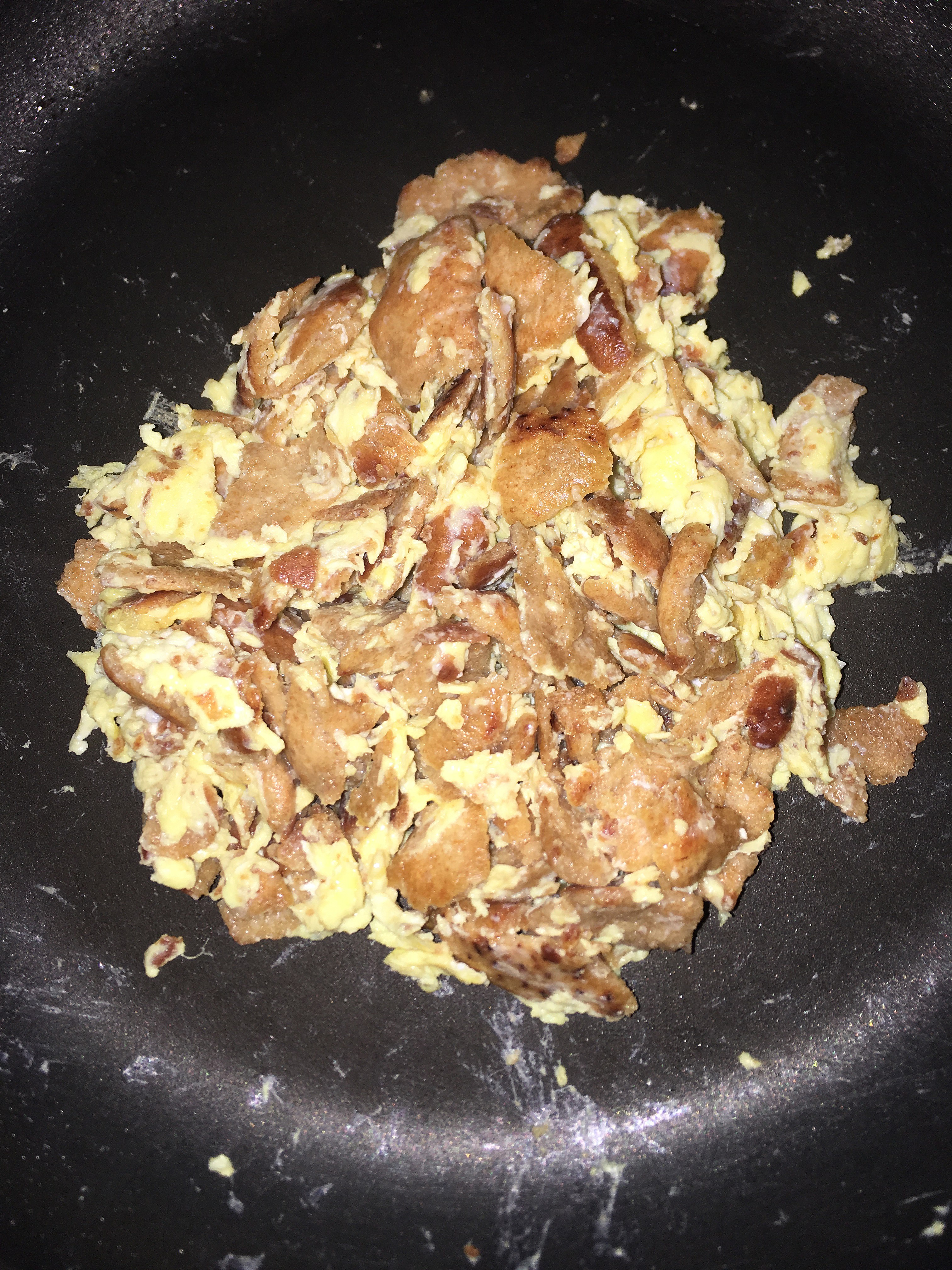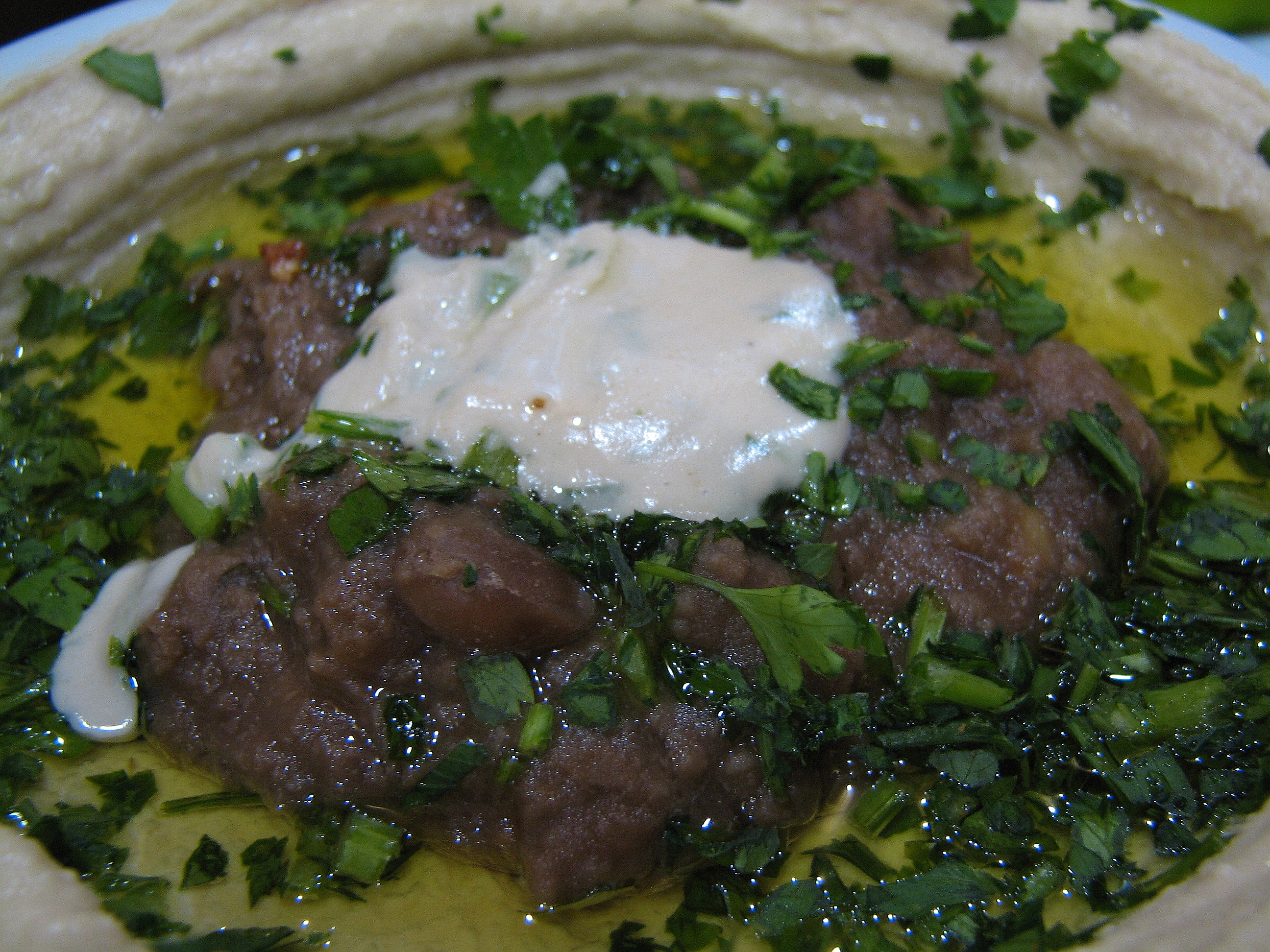|
Fatoot Samneh
Fatoot samneh ( he, פטאוט סמנה) is a dish originating in Yemeni cuisine, consisting of pieces of ''saluf'' or ''malawach'' (Yemeni flatbreads), or pita, that have been fried in clarified butter and combined with beaten egg. It is commonly served as a breakfast or dinner dish. It was brought to Israel by Yemenite Jews. It is somewhat similar to the Jewish cuisine, Jewish matzah brei or the Mexican American cuisine, Mexican-American migas, which are made with Matzah, matzo, and corn tortillas, respectively; whereas fatoot samneh is made with pita bread. Origins Fatoot samneh originated as a way for the Yemenite Jewish community to use and repurpose stale pita bread that would have otherwise been discarded. The Yemenite Jewish community was historically very poor, and most of their meals consisted of various soups and stews. Bread such as pita was very valuable, as was ''"samneh"'', or clarified butter, and their families were often large and the women of the community tra ... [...More Info...] [...Related Items...] OR: [Wikipedia] [Google] [Baidu] |
Yemenite Jews
Yemenite Jews or Yemeni Jews or Teimanim (from ''Yehudei Teman''; ar, اليهود اليمنيون) are those Jews who live, or once lived, in Yemen, and their descendants maintaining their customs. Between June 1949 and September 1950, the overwhelming majority of Yemen's Jewish population immigrated to Israel in Operation Magic Carpet. After several waves of persecution throughout Yemen, the vast majority of Yemenite Jews now live in Israel, while smaller communities live in the United States and elsewhere. Only a handful remain in Yemen. The few remaining Jews experience intense, and at times violent, anti-Semitism on a daily basis. Yemenite Jews have a unique religious tradition that distinguishes them from Ashkenazi Jews, Sephardi Jews, and other Jewish groups. They have been described as "the most Jewish of all Jews" and "the ones who have preserved the Hebrew language the best". Yemenite Jews fall within the "Mizrahi" (eastern) category of Jews, though they differ ... [...More Info...] [...Related Items...] OR: [Wikipedia] [Google] [Baidu] |
Mexican American Cuisine
Mexican-American cuisine is the cuisine of Mexican Americans and their descendants, who have modified Mexican cuisine under the influence of American culture and immigration patterns of Mexicans to the United States. What many recognize as Mexican cuisine is the product of a storied fusion of cultures and flavors. Its culinary adaptability has impacted its spread and popularity on a global scale and its presence in the United States is no exception. Culinary staples like tortillas, salsa, chips, chili, burritos, and tacos help to formulate many Americans' notions of Mexican food. Due in part to big business, immigration, and widespread likability, Mexican food and dishes have largely become regular constituents in American homes. While some of these popular iterations of Mexican food are far removed from their Mexican origins, they make up a large portion of the diets of many Americans. Additionally, more traditional Mexican cuisine has become more common in the United States ... [...More Info...] [...Related Items...] OR: [Wikipedia] [Google] [Baidu] |
Milchig
Mixtures of milk and meat ( he, בשר בחלב, basar bechalav, meat in milk) are forbidden according to Jewish law. This dietary law, basic to kashrut, is based on two verses in the Book of Exodus, which forbid "boiling a (goat) kid in its mother's milk" and a third repetition of this prohibition in Deuteronomy. Explanations for the law The rabbis of the Talmud gave no reason for the prohibition,''Hullin'' 108a but later authorities, such as Maimonides, opined that the law was connected to a prohibition of idolatry in Judaism. Obadiah Sforno and Solomon Luntschitz, rabbinic commentators living in the late Middle Ages, both suggested that the law referred to a specific foreign anaanitereligious practice, in which young goats were cooked in their own mothers' milk, aiming to obtain supernatural assistance to increase the yield of their flocks. More recently, a theogonous text named ''the birth of the gracious gods'', found during the rediscovery of Ugarit, has been interpre ... [...More Info...] [...Related Items...] OR: [Wikipedia] [Google] [Baidu] |
Resek Avganiyot
Resek agvaniyot, or resek (), is an Israeli condiment made of grated tomatoes that is traditionally served with malawach, jachnun, bourekas, kubaneh, and other dishes. It frequently paired with zhug, and is also commonly served as part of the Israeli breakfast. Origins Resek agvaniyot originated in the Yemenite Jewish community several hundred years ago, following the introduction of tomatoes to their cuisine, and as part of their traditional Shabbat morning meals. Overview Resek agvaniyot is a condiment made of salted, grated, fresh/raw tomatoes. It is somewhat similar to a salsa or a tomato puree, except it is never cooked and it always has a very fine, smooth consistency. Resek is a common condiment in Israel, and has been prepared by the Yemenite Jews for centuries, who traditionally pair it with zhoug and haminados (slow cooked eggs) and serve it with kubaneh, malawach, and jachnun as part of their Shabbat morning breakfast. With the arrival of Yemenite Jews to Is ... [...More Info...] [...Related Items...] OR: [Wikipedia] [Google] [Baidu] |
Zhug
Zhug ( he, סְחוּג, s'ḥug), sahawiq (Yemeni Arabic: ) or bisbas (Somali language, Somali: ) is a hot sauce originating in Yemeni cuisine. In other countries of the Arabian Peninsula it is also called ma'booj ( ar, معبوج}). Etymology The word ''sahawiq'' comes from the Arabic root (:wiktionary:سحق, s-ḥ-q) which means to pestle or to crush. Varieties Varieties in Yemen include (green sahawiq), (red sahawiq), and (sahawiq with cheese, usually Yemeni cheese). ''Sahawiq'' is one of the main ingredients of ''saltah''. ''Wazif'' (traditional Yemeni dried baby sardines) is sometimes added to the ''sahawiqs ingredients and it is known as ''sahawiq wazif'' ( ar, سحاوق وزف, link=no). In Israel, one can find ("red zhug"), ("green zhug") and ("brown zhug"), which has added tomatoes. Red zhug is made with red peppers while green zhug is made with green peppers, or jalapeños. Zhug may be referred to by the generic term ( he, חריף, link=no; lit. "hot/spi ... [...More Info...] [...Related Items...] OR: [Wikipedia] [Google] [Baidu] |
Tahini
Tahini () or tahina (, ) is a Middle Eastern condiment made from toasted ground hulled sesame. It is served by itself (as a dip) or as a major ingredient in hummus, baba ghanoush, and halva. Tahini is used in the cuisines of the Levant and Eastern Mediterranean, the South Caucasus, as well as parts of North Africa. Sesame paste (though not called tahini) is also used in some East Asian cuisines. Etymology ''Tahini'' is of Arabic origin and comes from a colloquial Levantine Arabic pronunciation of (), or more accurately (), whence also English ''tahina'' and Hebrew ''t'china'' . It is derived from the root , which as a verb means "to grind", and also produces the word , "flour" in some dialects. The word ''tahini'' appeared in English by the late 1930s.Mariposa, ''Hollywood Glamour Cook Book'', 1940, p. 101. ''Tahini'' is a loanword from modern Greek ''tachíni'' () which was originally adopted from the Ottoman Turkish ''"tahin"'' . In Turkish and also in Italian, ... [...More Info...] [...Related Items...] OR: [Wikipedia] [Google] [Baidu] |
Labneh
Strained yogurt, Greek yogurt, yogurt cheese, sack yogurt, or kerned yogurt is yogurt that has been strained to remove most of its whey, resulting in a thicker consistency than normal unstrained yogurt, while still preserving the distinctive sour taste of yogurt. Like many types, strained yogurt is often made from milk enriched by boiling off some water content, or by adding extra butterfat and powdered milk. In Europe and North America, it is often made from low-fat or fat-free cow's milk. In Iceland, a similar product named skyr is made. Strained yogurt is generally marketed in North America as "Greek yogurt" and in the UK as "Greek-style yogurt", though strained yogurt is also widely eaten in Levantine, Eastern Mediterranean, Middle Eastern, Central Asian and South Asian cuisines, where it is often used in cooking, as it curdles less readily when cooked. It is used in a variety of dishes, cooked or raw, savory or sweet. Straining makes even nonfat varieties thicker, richer, ... [...More Info...] [...Related Items...] OR: [Wikipedia] [Google] [Baidu] |
Laffa
Laffa, also known as lafa or Iraqi pita, is a large, thin flatbread in Israeli cuisine with an Iraqi origin. Laffa is a simple bread that is traditionally dairy-free and vegan and cooked in a ''tannur'' (tandoor) or ''taboon'' oven. It is most often used to wrap falafel, kebab, and shawarma to make sandwiches, to dip in hummus, matbucha and other dips, or with shakshouka, and other dishes. It is also the traditional bread used in sabich, an Israeli eggplant sandwich. Laffa is similar to many tandoor breads found in Asia including naan and pita. Though they are similar, laffa is unique in that it does not form a pocket and is much thicker and chewier than pita or naan. History Laffa is known as Iraqi pita given its origin among the Iraqi Jewish. Members of the Jewish community of Iraq, almost all of whom emigrated to Israel in the mid-20th century, brought with them the standard Iraqi flatbread known as ''aish tannur'' or simply ''khubz'' (bread). Laffa was traditionally ... [...More Info...] [...Related Items...] OR: [Wikipedia] [Google] [Baidu] |
Saluf
Markook bread ( ar, خبز مرقوق, khubz marqūq), also known as ''khubz ruqaq'' ( ar, رقاق), ''shrak'' ( ar, شراك), ''khubz rqeeq'' ( ar, رقيق), ''mashrooh'' ( ar, مشروح), and saj bread ( ar, خبز صاج), is a kind of Middle Eastern unleavened flatbread common in the Levant and the Arabian peninsula. It is baked on a convex metal griddle (a saj) or in a ''tannour''. ''Markook shrak'' is a type of thin bread. The dough is unleavened and usually made with only flour, water, and salt, and after being rested and divided into round portions, flattened and spread across a round cushion until it is thin then flipped onto the saj. It is often folded and put in bags before being sold. It is commonly compared to pita bread, also found in Middle Eastern cuisine, although it is much larger and thinner. In some Arab countries, such as Yemen, different names are given for the same flatbread, such as ''khamir'', '' maluj'' and ''ṣaluf'', depending on the regional di ... [...More Info...] [...Related Items...] OR: [Wikipedia] [Google] [Baidu] |
Fatoot
Fatoot ( ar, فتوت, Fatoot or Fatut) is a group of Yemen Yemen (; ar, ٱلْيَمَن, al-Yaman), officially the Republic of Yemen,, ) is a country in Western Asia. It is situated on the southern end of the Arabian Peninsula, and borders Saudi Arabia to the Saudi Arabia–Yemen border, north and ...i dishes based on shredded bread. References Yemeni cuisine {{Yemen-stub ... [...More Info...] [...Related Items...] OR: [Wikipedia] [Google] [Baidu] |
Fatoot Samneh
Fatoot samneh ( he, פטאוט סמנה) is a dish originating in Yemeni cuisine, consisting of pieces of ''saluf'' or ''malawach'' (Yemeni flatbreads), or pita, that have been fried in clarified butter and combined with beaten egg. It is commonly served as a breakfast or dinner dish. It was brought to Israel by Yemenite Jews. It is somewhat similar to the Jewish cuisine, Jewish matzah brei or the Mexican American cuisine, Mexican-American migas, which are made with Matzah, matzo, and corn tortillas, respectively; whereas fatoot samneh is made with pita bread. Origins Fatoot samneh originated as a way for the Yemenite Jewish community to use and repurpose stale pita bread that would have otherwise been discarded. The Yemenite Jewish community was historically very poor, and most of their meals consisted of various soups and stews. Bread such as pita was very valuable, as was ''"samneh"'', or clarified butter, and their families were often large and the women of the community tra ... [...More Info...] [...Related Items...] OR: [Wikipedia] [Google] [Baidu] |






